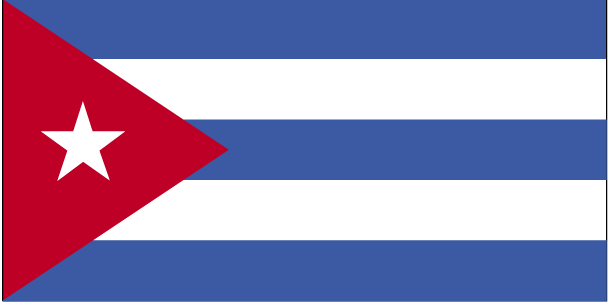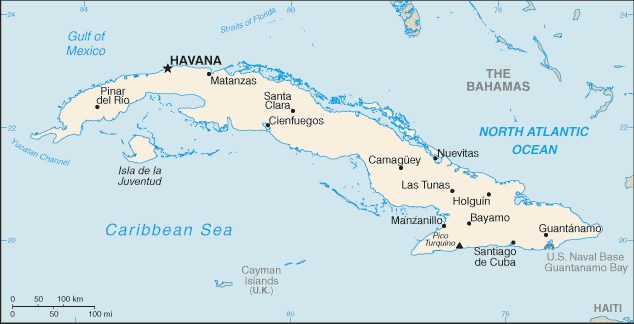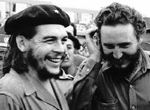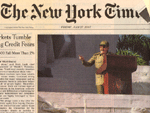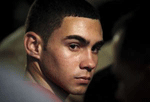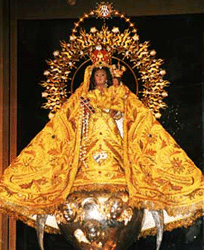CUBA
|
|
|
POPULATION:
11,500,000 (2009); 11,300,000 (2016)
CAPITAL:
La Habana
NAME:
República de Cuba > indigenous Cubanacan
NATIONAL HOLIDAY: 1
January 1959 (Castro revolution victory day)
GOVERNMENT: communist state
PRINCIPAL
CITIES: La Habana (2,300,000); Santiago de Cuba (500,000)
ETHNIC GROUPS (2002 census): European origin (61%); Mulatto/Mestizo (25%); Afro-Cuban (10%)
LANGUAGE: Spanish
RELIGION: Roman Catholic (85%); Protestant (10%); none (4%); Santería (1%)
LIFE EXPECTANCY: 2009: men, 75; women,80
LITERACY (2009): 99.8%
MONEY: Peso 092 pesos = $1.0 US (2007)
ECONOMY: main cropS = sugar; tobacco, citrus
EDUCATION: 9% of GDP (9th in world)
PER CAPITA INCOME = $9,700 (2009)
GEOGRAPHY: coastline (2,500 miles); 3 mountain ranges (Sierra Maestra highest); arable land (23%); highest point: Pico Turquino 2,005 m
HISTORY:
Brief bibliography for reading about Cuban history:
1. Jon Lee Anderson. Che Guevara; A Revolutionary Life. New York: Grove/Atlantic Inc., 1997.
2. Guillermo Cabrera Infante. Mea Cuba. Madrid: Grupo Santillana de
Ediciones, 1999.
3. Richard Gott. A New History. New Haven, Connecticut: Yale University Press, 2004.
4. Antoni Kapcia. Cuba; Island of Dreams. London: Oxford University Press, 2000.
5. Louis Pérez. The United States and Cuba in History and Historiography. The University of North Carolina Press: Chapel Hill, N.C., 1998.
6. Ignacio Ramonet and Fidel Castro. Fidel Castro; My Life; A Spoken Biography. New York: Scribner, 2008.
7. Tad Szulc. Fidel; A Critical Portrait. New York: Harper Collins Publishers, 1987.
8. Hugh Thomas. Cuba; or the Pursuit of Freedom, 2nd ed. London, 2001.
8,000 BCE – 1522 C.E. The Island of Cuba was Inhabited by Taíno, Siboney, Guanjatabey and Caribe peoples (almost all of these indigenous peoples died during the encounter with and conquest by the Spanish).
1492 Found
by Cristóbal Colón (
1510–1512 Cuba conquered by Spain (1512, Chief Hatuey taken prisoner and burned at stake).
1513 Diego
de Velázquez founded La Habana (becomes capital 1607).
1522 Slaves imported from Africa.
1605/1608 Silvestre de Balboa Troya y Quesada (1513-1620) wrote what is considered the first Cuban literary text from Cuba, Espejo de paciencia. Silvestre de Balboa was the notary for the town council (cabildo) of Santa María del Puerto del Príncipe. The work is a narrative epic poem about battles between Cubans and French pirates.
1608 Statue
reputed to represent Virgin Mary (Santa María) found in village of El
Cobre (copper) near Santiago de Cuba. This statue represents the patron saint of Cuba,
Our Lady of Charity (Nuestra Señora del Cobre). Click on this thumbnail
for an enlargement and an explanation of the Virgen del Cobre; see 2012 below.
1800–1801 Alexander von Humboldt arrived in Cuba after doing scientific exploration in Venezuela. From Cuba he sailed back to South American where he undertook extensive scientific research throughout the northern Andes.
1803–1839 José María Heredia, major Cuban poet in the school of romanticism. His most famous poem, written in exile, is Oda al Niágara (1824), a lyrical poem about Niagara Falls and his emotional longing to return to the paradise he thought Cuba was.
1805 Inter-racial marriage was banned by a policy promulgated by Spain and applicable throughout all Spain’s colonies.
1830 Facundo Bacardí I Massó (1814-1887; born in Catalonia, Spain) arrived in Spain: he created the first white rum in the world
1862 He founded Bacardí and Company in
1868 Facund's son, Emilio Bacardí Moreau
fought against
1901 Emilio Bacardí was elected mayor of
1902 The Bacardí Company invented the famous Cuban drinks, Cuba Libre and Daiquirí.
1951 José Bosch (the grandson-in-law of the founder of the Bacardí dynasty) takes over the company; he was a leader of the opposition during the Batista dictatorship. At first Bosch and the Bacardí family supported Fidel Castro (1959-1960).
1960 (July) José Bosch and his wife Enriqueta
Bacardí de Bosch went into self-exile in
(It
is worth studying three of the most prominent of the buildings built by the
Bacardí family: the
1837 First railroad opened in Cuba (railhead: La Habana).
1853-1895 José Martí, first-generation modernista essayist, poet, novelist, journalist, and father of Cuban Independence from Spain.
1868-1878 Ten Years War: Civil War between reformists and separationists vs. loyalists; the revolutionary rebels capitulate with Treat of Zanjón.
1875 José Martí initiates Latin American modernismo.
1878 Slavery abolished; Spain promised local rule but broke promise.
1892 José Martí founded Revolutionary Party (Partido Revolucionario Cubano).
1895-1898 War of
1895 José
Martí, father of Cuban independence, killed in war against
1898 (Apr) US declared war on Spain after sinking of USS Maine in Havana Harbor (Feb. 15).
Independence from Spain as result of Spanish American War; dependence on U.S.A.; Treaty of Paris.
1902 Independence from U.S.A. (20 May).
1902-1982 Wilfredo Lam: Vanguardist painter.
1903 USA leased Guantánamo Bay as naval base.
1906-1909 USA Marines police Cuba.
1917 Civil War.
1920-pres. Alicia Alonso (Alicia Ernestina de la Caridad del Cobre Martíez del Hoyo): legendary Cuban dancer and choreographer known as the Prima Ballerina Assoluta. She changed her last name to Alonso when she married the Cuban choreographer Fernando Alonso in 1935.
1921-pres. Carlos Franqui: pro-communist writer who was exiled in 1968 by Castro and who has continued campaigning against Cuba’s repressive communist government ever since.
1922-1980 Haydée Santamaría: revolutionary combatant with Fidel Castro in the failed assault on the Moncada Barracks in 1953; founder of Casa de las Américas publishing house in Cuba; and suicide in 1980 when depressed by repression under Castro.
1925 Cuban Communist Party founded.
1925-1933 Dictatorial rule by Cuba's fifth President, General Gerardo Machado y Morales (1871-1939).
1926-2016 Fidel Castro, born in Birán, Oriente Province, Cuba; died in Havana, Cuba. For a major newspaper article (November 26, 2016) that gives a complete, objective summary of Fidel Castro’s life, from birth to death, including major events in his life and his involvement in Cuban history, society, politics, culture, economy, and humanities, see: => Fidel Castro.
1932-2000 Heberto Padilla, Cuban poet, initially active pro-Castro writer, then exiled by Castro in part for being homosexual; committed suicide in exile.
1933-2009 Orlando “Cachaíto” López, played the string bass with the Buena Vista Social Club (with Compay Segundo, Ibrahim Ferrer, Rubén González, and Omara Portuondo. Cachaíto López was a pioneer of Cuban mambo music.
1933 General strike; violence; Machado's violent repression; he was overthrown by US intervention and student demonstrations.
1933-1944 Rule by dictator Gen. Fulgencio Batista with puppet president-dictators.
1943-1990 Reinaldo Arenas, poet, playwright, novelist, at first pro-Castro, then opposed Castro strongly; exiled for being anti-Castro and a homosexual; committed suicide in New York.
1952-1959 Batista dictatorship.
1953 Fidel Castro (1926 – present) begins guerrilla war vs. dictatorship; July 26, 1953, Castro’s failed attack on Moncada barracks.
1956-1959 Cuban Revolution; December 2, 1956 Castro and revolutionaries land in the yacht Granma from Mexico; 1956-1958: guerrilla war in Sierra Maestra.
1959[1] (Jan 1) Victory by Fidel Castro against the Batista dictatorship with the help from the Argentinian medical doctor Ernesto (Che) Guevara (1928-1967; born in Argentina) and many sectors.
.
1959-1962 1,000,000 Cubans immigrate to USA.
1960 Banks and industries nationalized.
1960-1962 Cuban government declares policy of “Patria Potestad,” which meant that the government had authority over Cuban children; as a reaction, the Catholic Church and the US Department of State carried out “Operation Peter Pan,” by which 14,000 Cuban children were flown to the United States and either placed with family members or with foster families and orphanages according to religious affiliations.
1961 Bay of Pigs (Bahía de los Cochinos) invasion by C.I.A. failed
1962 (Oct22) Missile crisis averted (USSR removes missiles).
1978 Cuba initiates a program called “El Diálogo” by which exiled (or self-exiled) intellectuals and artists could return to Cuba. Ana Mendieta was one of the founding members of this partial “return” to Cuba.
1984-1989 Cuba intervenes in civil war in Angola.
1989 Gen. Arnaldo Ochoa Sánchez and José Abrantes (former Internior Minister) expelled from PC Cuba for narcotráfico.
1991 Cuban troops removed from Angola.
1994 Exodus of 30,000 “boat people” to Miami.
1996 Cuban air force shot down 2 planes near Cuban air space flown by anti-Castro exile group based in Miami.
2000 Elián González custody case in Miami results in the young boy, whose mother and others died in the Strait of Florida trying to escape from Cuba, being returned to his father in Havana (see 2010 below).
2007 July 26: Fidel Castro gives power to brother Raúl Castro, due to Fidel Castro's serious stomach illness. Click on the following image to see the New York Times front page photograph of this event (July 27, 2007):
2007 "Cuba Avant-Garde:
Contemporary Cuban Art from the Farber Collection", exhibition at the Harn
Museum at the University of Florida (Fall semester).
2008 (December
8) Benicio del Toro (actor; born 1967; Puerto Rico) and Steven Soderbergh (born
1963; American film director) hold a press conference in La Habana in which the
present the movie about Che Guevara (“Che”). The press conference
is reported in the official government newpaper, Granma, p. 5:
2008 Raúl
Castro took over as chief of state and president of Council of State and
president of Council of Ministers following election by 100% of electorate
(next election, 2013).
2010 Elián
González appears in public in Cuba for the first time in ten years since
he returned from his relatives in Miami to his father in Havana. For an article
about this event, see the attached .pdf file:
2012
(March), Pope Benedict XVI visits three sites in Cuba, Havana, where he lands,
Santiago de Cuba at the eastern end of the island, and the village of El Cobre,
near Santiago. The latter place is where the statue of Mary, that is, Our Lady
of Charity (Nuestra Señora del Cobre), the patron saint of Cuba, is
located in the Basílica Santuario Nacional de Nuestra Señora de
la Caridad del Cobre). The shrine was built in 1926, and the feast day for this
patron saint is September 8. For a the welcoming speech by Raúl Castro
and Benedict, see: => Two Speeches.
The next day, the pope received Fidel Castro at the bishop’s palace in
Havana, where the two veteran leaders (see: =>
Primary Document)
“conversed animatedly.”
2014 (October),
Cuba sends doctors and other medical personnel to Liberia (52) and Guinea (40)
to join the world-wide campaign to fight the spread of Ebola in West Africa.
The doctors work to produce an anti-Ebola serum from the blood of infected
people.
2016 7TH
Cuban Communist Party congress (17 April). Fidel Castro made brief appearance
saying, “The ideas of the Cuban communists will endure.”
Raúl Castro referred to the visit to Cuba earlier in 2016 by President
Obama (USA) as a “perverse strategy of political-ideological
subversion.” Raúl Castro also said Cubans “must reinforce
anti-capitalist and anti-imperialist culture among ourselves … [If] they
manage some day to fragment us, it would be the beginning of the end […]
of revolution, socialism, and national independence.”
November
25, 2016: Fidel Castro, age 90, died in Havana Cuba. The funeral was held on
November 26th, and he was interred in Santa Ifigenia Cemetery in
Santiago de Cuba.
GOVERNMENT: Communist state; dictatorship; President Raúl Castro Ruz (2008 - ) (President Fidel Castro Ruz (1926-2016 ; 1959-2006/2008); Cuba has 14 provinces
MILITARY: 17 – 49 age: 92,000 men; 89,000 women
CHIEF EXECUTIVE: Raúl Castro Ruz, president of
Communist Party and dictator
MAJOR POLITICAL PARTIES: Communist Party (one-party state): PPC (Partido Popular de Cuba)
PRINCIPAL MEMBERS OF INTELLIGENTSIA:
Silvestre de Balboa (b. Canary Islands, 1563-1647), author of first piece of Cuban literature, the epic poem Espejo de Paciencia about Cubans’ victory over French pirates in 1604. The work was lost and rediscovered in 1836.
Félix Varela (1787-1853), anti-slavery essayist.
José María Heredia (1803-1839),
romantic poet: Oda al Niágara
(1824).
Cirilo Villaverde (1812-1894); novelist in the romantic-realist school: Cecilia Valdés (1880’s).
Gertrudis Gómez de Avellaneda (1814-1873), Romantic feminist poet.
José Martí (1853-1896), poet, essayist, father of Cuban independence: Ismaelillo (1882); Versos sencillos (1891); father of Latin American Modernism (1875).
Julián del Casal
(1863-1893), Modernist poet.
Nicolás Guillén (1902-1989), Vanguardist poet; Afro-Cuban journalist; political activist. He was Cuba’s national poet.
Alejo Carpentier (1904-1950),
novelist and creator of Magical Realism / lo
real maravilloso.
El reino de este mundo (1949)
Los pasos perdidos (1957)
El siglo de las luces (1962)
José Lezama Lima
(1910-1976), Vanguardist poet and novelist, Paradiso (1966)
Guillermo Cabrera Infante
(1929-2005), novelist: Tres tristes
tigres (1967); Vista del amanecer en el trópico
(1974); Mea Cuba (1992; anti-Castro
book of essays).
Roberto Fernández Retamar (b. 1930), pro-Castro poet and director of publishing house Casa de las Américas since 1965.
Severo Sarduy (1937-1993), poet, short story writer, jouralist, literary critic; committed suicide in exile in Paris.
Leonardo Padura (b. 1955),
mystery novelist; La novela de mi vida
(2005).
SIGNIFICANT
CUBAN FILMS (selection):
Memorias del subdesarrollo by Tomás
Gutiérrez Alea (1968).
Lucía by Humberto Solás
(1969)
Fresa y chocolate by Tomás
Gutiérrez Alea and Juan Carlos Tabío (1993)
Che by Steven Soderbergh with Benito
del Toro (4 ½ hour movie about Che Guevara by the American director;
2008)
